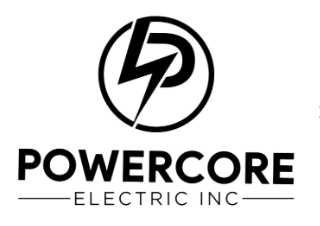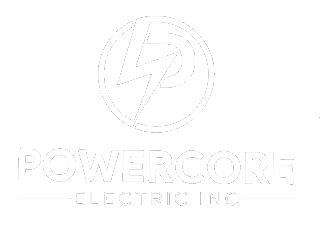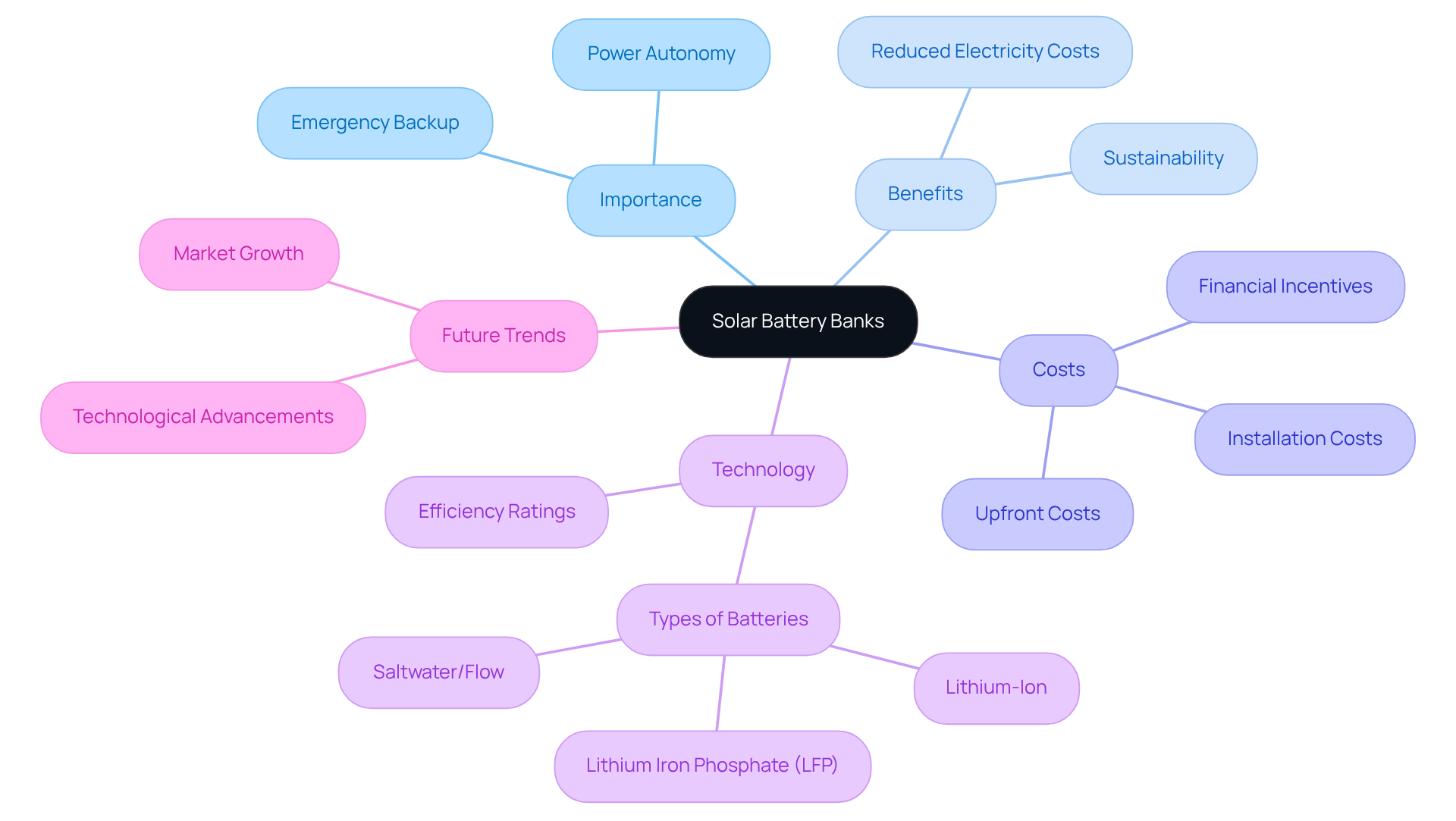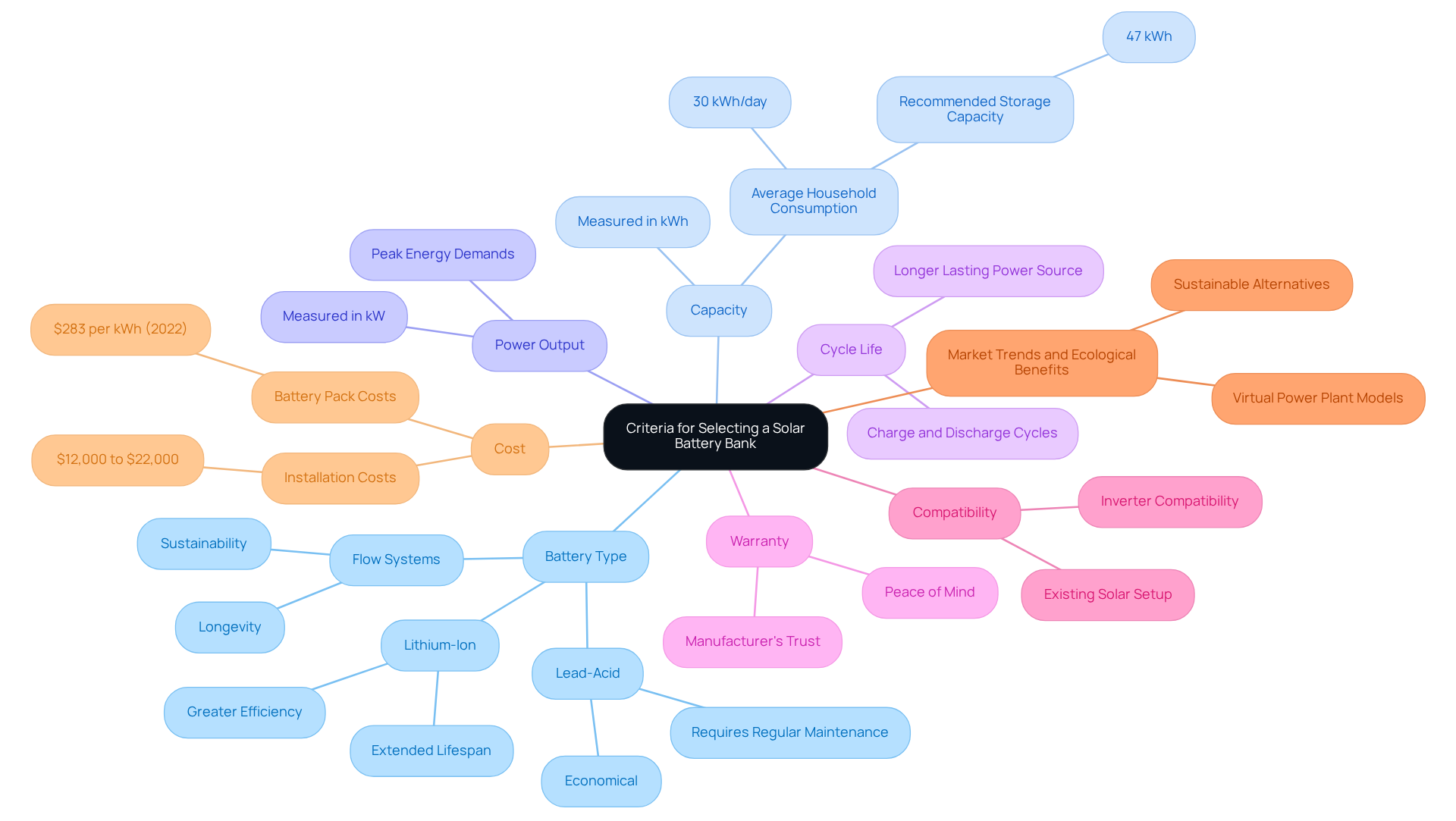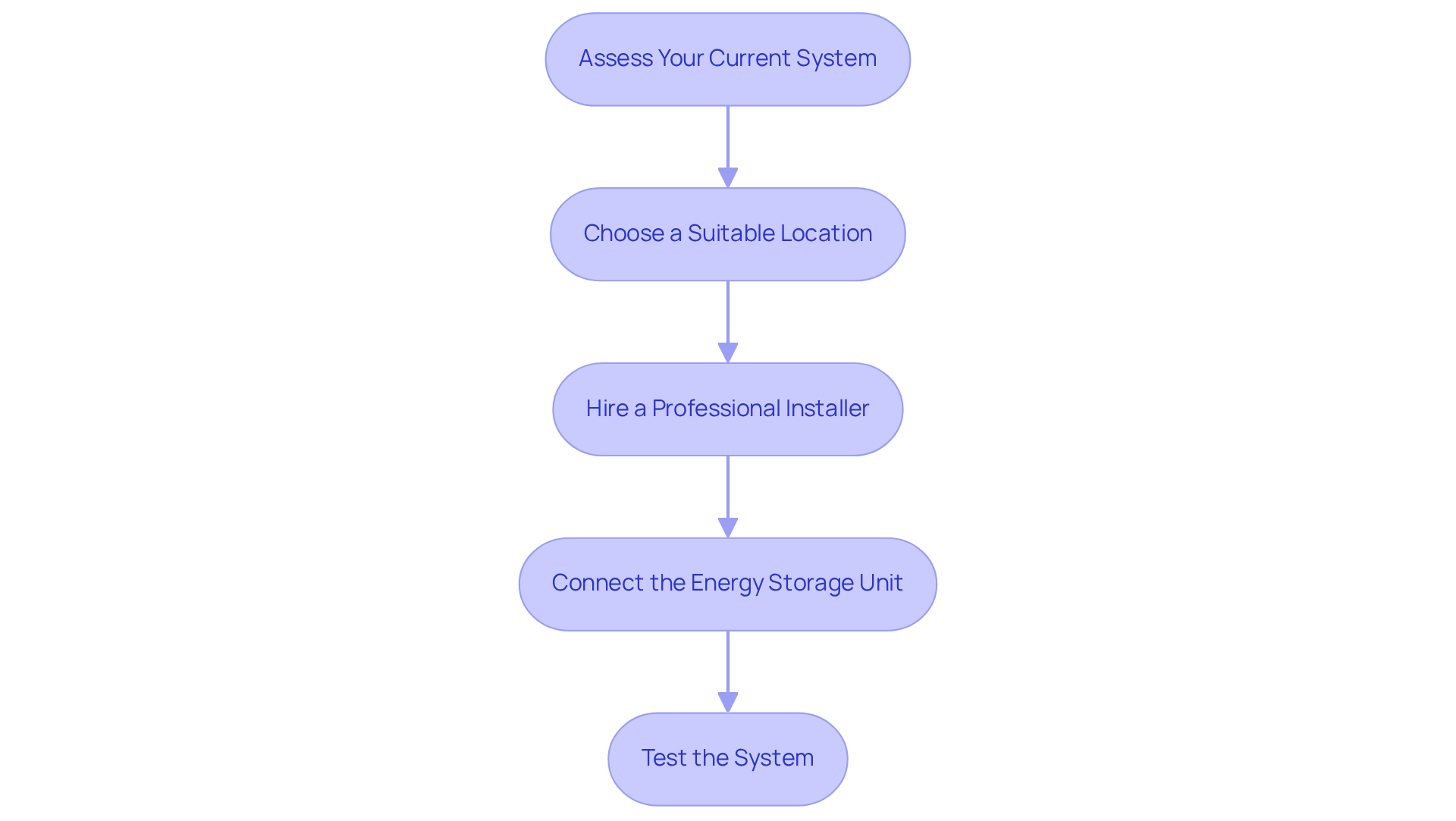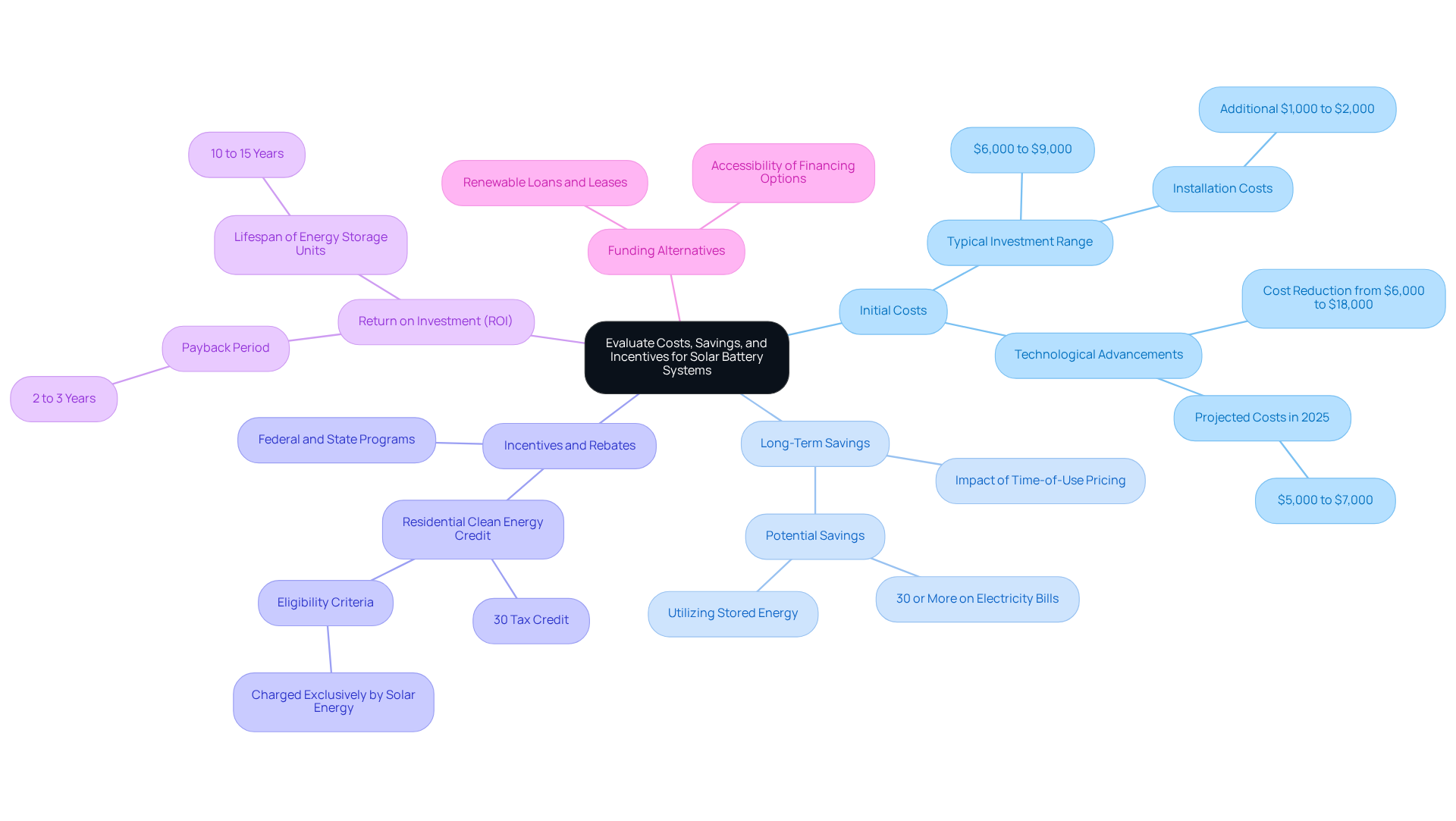Overview
Understanding the rising costs of energy bills can be overwhelming, and many homeowners are searching for solutions that not only ease their financial burden but also contribute to a sustainable future. The best solar panel battery bank for your home is essential in this journey, as it allows you to store excess solar energy, enhancing your energy independence and reducing electricity costs—especially during outages or peak demand periods.
Imagine the peace of mind that comes with knowing you have a reliable source of energy, even when the grid is down. Selecting the right battery bank involves considering key criteria such as:
- Battery type
- Capacity
- Compatibility with your existing systems
These factors are crucial in ensuring that your investment pays off in the long run. Moreover, there are financial benefits and incentives available to homeowners who choose to invest in renewable energy solutions, making this an even more attractive option.
It’s common to feel unsure about where to start, but remember, you’re not alone in this. Together, we can explore the options that best suit your needs and lifestyle. By embracing solar energy, you are not just making a choice for today; you are investing in a brighter, more sustainable future for yourself and your family. Let’s take this step towards energy independence together, and feel free to reach out for guidance and support on your solar journey.
Introduction
We understand that the rising costs of energy bills can be a significant concern for homeowners. This has led many to explore innovative solutions, particularly in harnessing solar power through the integration of battery banks. These systems not only store excess energy generated during sunny days, but they also provide a reliable backup during outages. This ultimately enhances your energy independence and can significantly reduce your electricity costs.
However, with a myriad of options available, it’s common to feel overwhelmed when trying to determine the best solar panel battery bank for your unique needs. Together, we can navigate this journey. This article delves into the essential steps for selecting the right solar battery bank. We will address key criteria, installation practices, and the financial incentives that make this investment increasingly attractive. By understanding these aspects, you can make informed decisions that align with your values and energy goals.
Understand Solar Battery Banks and Their Importance
The best solar panel battery bank for home is an essential setup that helps retain surplus power generated by solar arrays for future use, significantly enhancing power autonomy. We understand that homeowners want to capture renewable power even when the sun isn’t shining, especially in areas prone to outages or where electricity costs can fluctuate dramatically. Consider the February 2021 winter storm in Texas; many homeowners with battery storage systems managed to keep their power while over 4 million residents faced outages. This underscores the reliability of these systems during crises.
By effectively conserving power, homeowners can reduce their reliance on the grid, leading to lower electricity costs and a reliable power supply during outages. Did you know that the average electric bill in the U.S. is around $290 monthly? Utilizing stored renewable power can help lessen these expenses, particularly during peak demand periods when utility rates are at their highest. Solar storage solutions typically range from $1,000 to $2,000 per kWh of power retention, with installation costs often exceeding $3,000.
Experts agree that using the best solar panel battery bank for home in a renewable power system not only provides backup electricity but also boosts overall efficiency. With advancements in technology, modern like the Tesla Powerwall, Bluetti, and EcoFlow are considered the best solar panel battery bank for home, offering impressive storage capacities and extended lifespans, making them a wise investment for homeowners seeking energy resilience. For instance, the Tesla Powerwall can hold 13.5 kWh of power and comes with a 10-year warranty, while Bluetti and EcoFlow provide various options to meet different power needs.
In addition to financial savings, the best solar panel battery bank for home provides significant contributions to a more sustainable energy future. They empower homeowners to maximize the use of their generated electricity, reducing dependence on fossil fuels, which account for about 60% of grid power in the U.S. Furthermore, financial incentives such as the Residential Clean Energy Credit, which can cover up to 30% of total purchase and installation costs, make these solutions even more appealing. As the photovoltaic sector grows, the adoption of storage systems is expected to double in home projects by 2028, signaling a significant shift towards sustainable energy solutions.
However, it’s important for potential users to consider the challenges of energy storage, including high upfront costs and complexity. As Powercore Electric highlights, “Storing energy produced by the sun with energy storage systems provides greater independence, but it might not suit everyone.” This balanced perspective helps homeowners make informed decisions about integrating energy storage systems into their renewable solutions. Together, we can work towards a more sustainable and resilient energy future.
Identify Key Criteria for Selecting a Solar Battery Bank
When it comes to selecting the , we understand that navigating the options can feel overwhelming. Several key criteria can guide your decision-making process, ensuring you choose the right solution for your energy needs:
- Battery Type: The two most common varieties are lithium-ion and lead-acid cells. Lithium-ion cells generally provide greater efficiency and extended lifetimes, making them a favored option for the best solar panel battery bank for home. In contrast, lead-acid cells are typically more economical but demand more regular upkeep and have a shorter lifespan. New alternatives such as flow systems are also attracting interest for their sustainability and longevity.
- Capacity: This metric shows the amount of power the cell can hold, typically measured in kilowatt-hours (kWh). To determine the appropriate capacity for your needs, assess your household’s daily energy consumption. For example, an average household uses around 30 kWh each day, indicating a storage capacity of roughly 47 kWh for sufficient backup. Typically, 2 to 3 of the best solar panel battery banks for home are needed to power a house, depending on your goals and storage capacity.
- Power Output: Measured in kilowatts (kW), power output indicates how much power the storage unit can provide at any given moment. It’s crucial to ensure that the output can meet your peak energy demands, especially during high usage periods.
- Cycle Life: This refers to the number of charge and discharge cycles a cell can endure before its capacity significantly declines. A higher cycle life signifies a longer-lasting power source, which is essential for maximizing your investment.
- Warranty: Choose power sources that include a solid warranty, as this frequently indicates the manufacturer’s trust in the product’s longevity and efficiency. A solid warranty can provide peace of mind regarding your investment.
- Compatibility: Ensure that the energy storage system is compatible with your existing solar setup and inverter. Compatibility is vital to avoid integration issues that could hinder performance and efficiency.
- Market Trends and Ecological Benefits: Consider the broader market trends, such as the impact of virtual power plant business models, which can enhance the value of your energy storage investment by participating in flexibility markets. Furthermore, assess the ecological advantages of various power sources, as sustainable alternatives can aid in creating a more environmentally friendly future.
By thoughtfully assessing these standards, you can make knowledgeable choices that enhance the effectiveness and dependability of the best solar panel battery bank for home. Additionally, considering the expense of power packs, which was $283 per kilowatt-hour in 2022, can assist in planning for your investment. Insights from the “Residential Battery Storage Cost Projections” case study further emphasize the importance of evaluating costs over time. Together, we can work towards a sustainable energy future that meets your needs.
Plan for Installation and Integration with Existing Solar Systems
Are you feeling overwhelmed by rising energy bills? You’re not alone. Many homeowners are seeking sustainable solutions to regain control over their energy consumption. Integrating the best solar panel battery bank for home with your existing solar system can be a significant step towards achieving energy independence. Here’s how to make this transition seamless and effective:
- Assess Your Current System: Start by evaluating your photovoltaic panels and inverter. It’s essential to confirm their compatibility with the new energy storage unit. Consulting with your energy provider can ensure a smooth integration. Understanding how your solar panels operate will empower you to make informed choices about the best solar panel battery bank for home that can enhance efficiency.
- Choose a Suitable Location: Selecting a cool, dry, and easily accessible location for the battery bank is crucial for maintenance. Ensure that your chosen site complies with local construction codes and safety regulations. This attention to detail can significantly affect the performance and longevity of your setup.
- Hire a Professional Installer: While the idea of DIY installation may be tempting, is highly recommended. Their expertise ensures safety and compliance with local regulations, streamlining the integration process and minimizing the risk of costly mistakes. A well-executed installation can enhance your system’s operational efficiency and lifespan.
- Connect the Energy Storage Unit: The technician will link the energy storage unit to your solar setup, ensuring proper wiring and configuration. This connection may involve linking to the inverter and adjusting the setup for optimal performance, which is vital for maximizing power storage and utilization.
- Test the System: After installation, it’s important to conduct a thorough test to ensure the battery bank is functioning correctly. Observing the system over several days will help verify that it integrates smoothly with your photovoltaic panels, providing reliable backup energy during outages and improving your energy autonomy.
Additionally, you might be pleased to know that tax credits and Energy Trust incentives could be available to help reduce installation costs for photovoltaic setups. This can make your shift to renewable energy and storage more financially viable. Consider options like lithium-ion cells, which offer high efficiency and extended lifespans, or lead-acid cells, which are more economical but have shorter lifespans. By following these steps, you can enhance your energy setup by incorporating the best solar panel battery bank for home, ensuring you benefit from increased resilience and reduced dependence on the grid. Together, let’s work towards a more sustainable future.
Evaluate Costs, Savings, and Incentives for Solar Battery Systems
When considering a solar battery bank, it’s essential to evaluate the financial aspects that can significantly impact your energy independence and savings:
- Initial Costs: We understand that the price of battery systems can vary widely based on capacity, type, and installation complexity. Homeowners typically invest between $6,000 and $9,000 for a standard residential setup, including installation costs. This is a significant reduction from the previous range of $6,000 to $18,000, thanks to advancements in technology and market dynamics that are driving costs down. Additionally, don’t forget to include the expense of EV chargers, like Tesla home chargers, as part of your total investment in sustainable power solutions.
- Long-Term Savings: Imagine utilizing stored sunlight during peak hours and experiencing substantial savings on your electricity bills. This could potentially reduce your reliance on grid power by 30% or more, especially in regions with high utility rates where electricity costs can fluctuate dramatically. Moreover, combining energy storage units with electric vehicle charging options can enhance your savings even further by allowing you to charge your vehicles using harvested renewable energy.
- Incentives and Rebates: It’s important to explore local and federal incentives for energy storage installations. The Residential Clean Energy Credit offers a 30% tax credit on the total cost of qualifying energy storage systems installed from 2023 to 2032, significantly reducing your installation costs. Just ensure that your power source is replenished solely by sunlight to qualify for this tax credit. Additionally, government initiatives aimed at encouraging renewable energy adoption can provide further financial assistance.
- Return on Investment (ROI): To assess your ROI, consider contrasting the overall expenses of the energy storage unit with the expected savings throughout its lifespan, which may vary from 10 to 15 years. A well-executed investment can yield considerable financial benefits, with payback periods typically around 2 to 3 years. Plus, remember that you can claim a distinct tax credit for battery systems installed in a different tax year from your photovoltaic panels, according to IRS guidelines.
- Funding Alternatives: Explore funding solutions such as renewable loans or leases, which can help manage initial expenses while still allowing you to benefit from cost savings. These options can make the transition to renewable energy more accessible and financially feasible. With projections indicating that may decrease to around $5,000 to $7,000 by 2025, now is a wonderful time to invest in the best solar panel battery bank for home, especially when combined with EV charging solutions. Together, we can work towards a more sustainable future.
Conclusion
Choosing the best solar panel battery bank for your home is a decision that truly matters, one that can significantly enhance your energy independence and sustainability. We understand that managing energy bills can be a concern, and by effectively harnessing and storing solar energy, you can ensure a reliable power supply during outages, reducing your reliance on the grid. This not only leads to substantial savings on electricity bills but also contributes to a greener future by decreasing dependence on fossil fuels.
Throughout this article, we highlighted key factors such as:
- Battery type
- Capacity
- Power output
- Cycle life
- Warranty
- Compatibility
as essential criteria for selecting the right solar battery bank. We also discussed the financial implications, including initial costs, long-term savings, available incentives, and potential return on investment, emphasizing the importance of thorough evaluation before making a purchase.
In light of the growing demand for renewable energy solutions, investing in a solar battery bank represents a significant step toward energy resilience and sustainability. With advancements in technology and favorable incentives, now is an opportune time to explore options that best meet your individual energy needs. Embracing this transition not only empowers you as a homeowner but also plays a vital role in fostering a sustainable energy future for all. Together, let’s work towards a greener tomorrow, ensuring that your energy choices reflect your values and aspirations.
